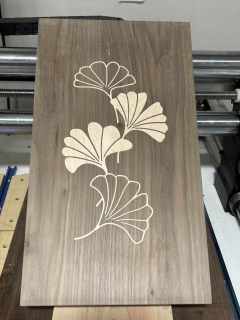SignTorch
Artist
hmmm, a .005" flat tip is way more fragile than .016", and I don't think the design is any thinner anywhere, in fact I eliminated the very thinnest sections and scaled it up 111% to make sure that wide(er) bit would fit, so I'm not sure why its not working better
make sure you define the bit tip diameter and side angle exactly in the tool database, and zero the bit on the material moderately exactly, and exactly as defined in the toolpath, and then make sure the cut is the same size as the drawing, and just do small simple test cut patterns until you are sure about all that before cutting a detailed inlay with thin features like that because that's just learning the hard way
bit breakage usually has to do with incorrect pass depth and feed rate for the given tool size and rpm, let me know your bit specs and rpm and I'll advise what pass depth and feed rate to try, with wood its fairly straightforward to calculate reasonably
make sure you define the bit tip diameter and side angle exactly in the tool database, and zero the bit on the material moderately exactly, and exactly as defined in the toolpath, and then make sure the cut is the same size as the drawing, and just do small simple test cut patterns until you are sure about all that before cutting a detailed inlay with thin features like that because that's just learning the hard way
bit breakage usually has to do with incorrect pass depth and feed rate for the given tool size and rpm, let me know your bit specs and rpm and I'll advise what pass depth and feed rate to try, with wood its fairly straightforward to calculate reasonably

